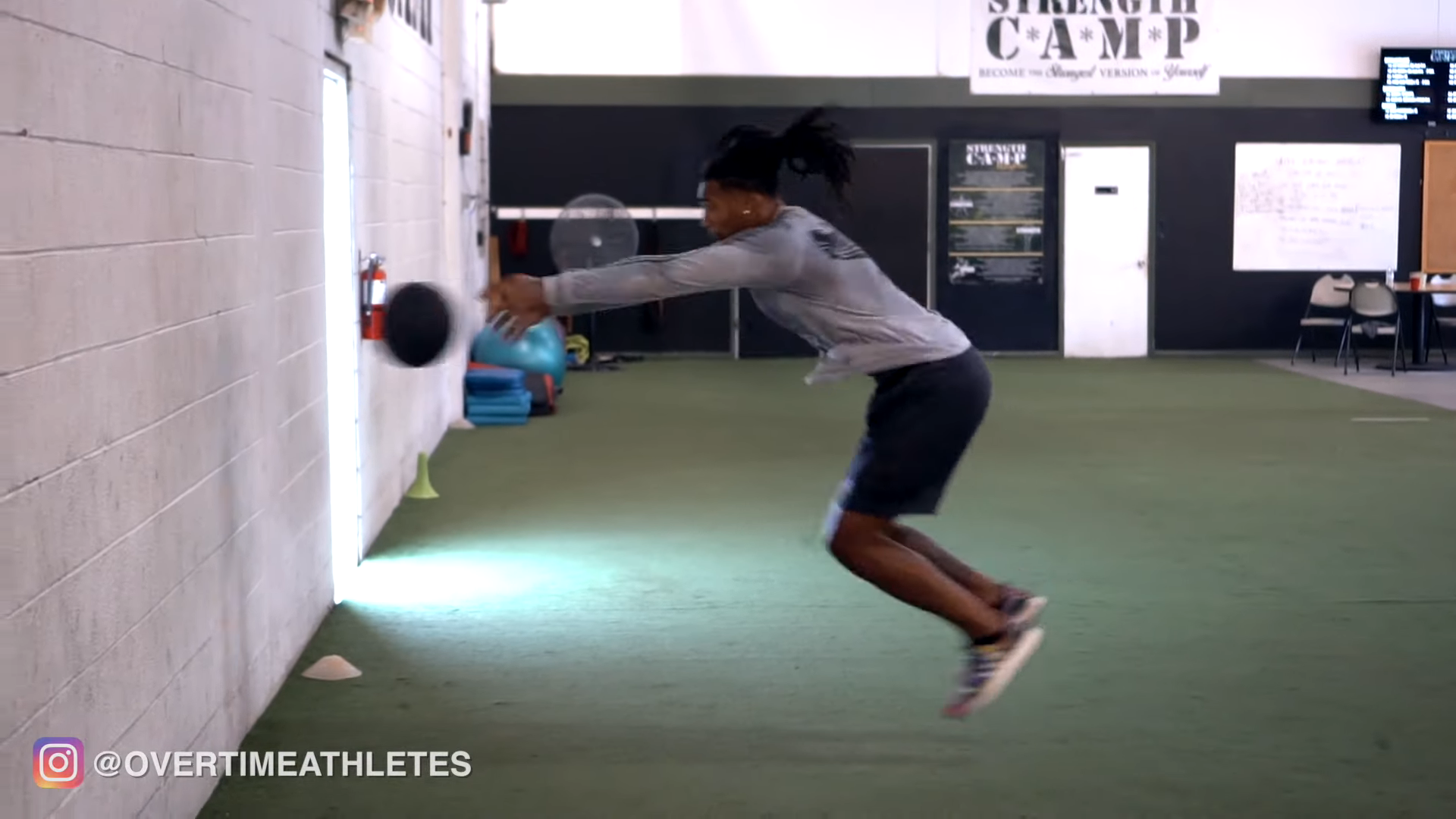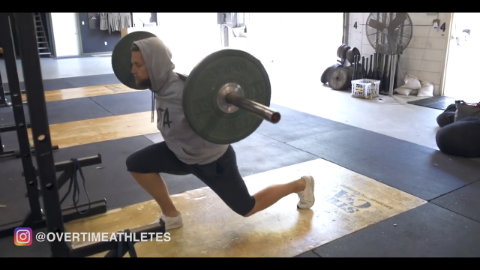Speed Pillar #1: Relative Force Production
If you read my last post on the 3 Pillars of Speed Development, you know that the first pillar of speed development is Relative Force Production. Over my decade of coaching, I’ve realized that guys with the highest verticals, broads, and strength, relative to their bodyweight.

In this post, I want to share what relative force production is, why it’s important… And of course, how to develop it.
What is Relative Force Production?
If you don’t know, relative force production is the amount of force you can produce relative to your bodyweight.

So, if one athlete has a 40 inch vertical and weighs 200 pounds, and another has a 36 inch vertical and weighs 200 pounds, the athlete who has the 40 inch vertical has higher relative force production.
Same if one athlete weighs 200 pounds and squats 300 while another weighs 200 pounds and squats 250.
Why is Relative Force Production Important for Speed?
When an athlete accelerates, he’s producing high amounts of force in the horizontal plane. As he transitions into the top speed, or max velocity phase, he’s producing force vertically AND horizontally.
So, the more force an athlete can produce, obviously, the faster he’ll run, the longer his strides will be, the quicker his first step will be.

Additionally, an athlete must have the base level of strength to keep his body in the proper positions during a sprint.
Some athletes who lack this strength have heavy feet, and they collapse every time they make contact with the ground. Others are too weak to keep their core tight while running, which results in faulty running mechanics.
These two examples, and more, are why relative force production are absolutely critical if you want to run faster.
The Best Way to Increase Your Relative Force Production
There are two aspects to improving your relative force production.
The first is building your absolute strength, the second is increasing your explosiveness, or elastic strength.

If you have absolute strength without the elastic strength, you might be able to hold yourself in the right positions while propelling yourself down the field, but you won’t have that bounce. You won’t have the powerful strides that almost make it look like you’re gliding down the field.
You need both absolute strength and explosiveness (the ability to display strength quickly) for speed
Below, I’m going to share my favorite methods to build each.
How to Build Absolute Strength
Below, I’m going to share a little bit of the absolute strength methodologies I use in my Athletic Speed System.
First, you should know that when it comes to speed, I like to stick to three compound lifts for the lower body to improve absolute strength.

The first is the trap bar deadlift.
Trap bar deadlift is a great movement to build the posterior chain, the low back, hamstrings, and glutes. Athletes can also move the bar at higher velocities than they can with a back squat or a traditional deadlift. This makes it more transferrable to speed.
The second movement I like to use is the back squat. I really like to use Triphasic training methods with the back squat to manipulate neuromuscular mechanisms in the body to move more weight and allow the muscles to contract harder.

The third movement I like to use to build absolute strength is the reverse lunge.
I like the reverse lunge because you’re producing force with a positive shin angle, similar to the shin angle an athlete has during acceleration. Also, this movement is easy to progress.
Progressions for Absolute Strength
If you’ve read anything I’ve written, you know I’m all about progression.
If you don’t have a plan for progression, you can’t progress.
And many athletes who program for themselves definitely don’t have a progression planned.

This occurs because many athletes are short-sighted with their training. But, if you take a step back and take a long term approach. You’ll be heavily rewarded.
So, here I want to share the general strength progression I use with my athletes.
It may vary time to time, but this is the gold standard in the OTA gym.
Here’s the parameters for a four week block:
Wk 1: 5×4
Wk 2: 5×3
Wk 3: 5×2
Wk 4: Deload
In order to make continuous strength gains, you need to progress your movements in addition to your training intensity.

To accomplish that, you can add some variation to your movements. For example, with the reverse lunge, you can increase the range of motion by reverse lunging off a box. You can also perform a barbell reverse lunge, and even a barbell elevated reverse lunge.
How to Increase Your Explosiveness and Build Elastic Strength
Elastic strength is the bridge between your absolute strength and speed.
To build elastic strength and increase your explosiveness, we’ll rely on two methods.
The first method is plyometric training.

When it comes to plyometrics, I like to boil it down to an extremely simple progression.
First, I work on the athletes landing mechanics to raise their force absorption capacity. This will help them produce more powerful strides. It will also help them produce more force in the long run.
After we’ve honed landing mechanics, we move to their transition. The goal of this phase is to reduce ground contact time. This will carry over into a sprint by making the athlete lighter on their feet.

Finally, in the last phase, I focus on all out force production. I’m utilizing modalities to raise the athlete’s force output as much as possible.
The second method for building elastic strength is Triphasic training.
Triphasic training emphasizes each portion of movement for every block of training.
Triphasic Training Block #1: Eccentric
In the first block of training, we emphasize the eccentric portion of movement. This works the muscles in absence of the stretch reflex, and GTO inhibition.
If you don’t know, the stretch reflex is a neuromuscular response that signals your brain to contract your muscles.

GTO inhibition, on the other hand, is a neuromuscular response that signals your brain to relax a muscle because it’s contracting with too much force.
The reason we want to train in absence of these two neuromuscular mechanisms is because we can teach the body to produce more force without these mechanisms. I explain it more in-depth here, but essentially, GTO inhibition is overactive, and tells the brain to relax at 60% of the maximum force a muscle can contract at. If we can bypass this mechanism, we can teach the muscle to produce more force.
Triphasic Training Block #2: Isometric
In the second block of training, we emphasize the isometric portion of the movement. If you think of a squat, the isometric portion of movement is the time between the lowering and raising portion of movement.
When we emphasize this portion of movement, we teach the muscle to activate larger, fast-twitch motor units during movement.

If you don’t know, motor units are responsible for the contractions of muscles. When we emphasize the isometric portion of movement, we exhaust first-responding motor units. When these motor units are exhausted, your body recruits larger fast-twitch motor units as reinforcement.
After performing this kind of training over and over again, you teach the body to make those fast twitch motor units the first responders.
Triphasic Training Block #3: Concentric
In the third block of training, we emphasize the concentric portion of the movement. If you think of a squat, the concentric portion is the up phase.
When we emphasize this portion of movement, we increase our rate of force development.

Rate of force development is the speed at which you can produce force.
In other words, it’s your explosiveness.
Of course, the third block of training is a culmination of the first two. Developing all of these qualities has culminated into increased explosiveness and elastic strength.
The Proven Method to Increase Relative Force Production
You might lnow that over the years, I’ve researched, tested, and put into practice, the different methods to produce more force, build more strength, and become more explosive.
I’ve compiled those and placed them into a research-backed, field-tested system…

Athletic Speed System takes the 3 pillars of speed development and gives you a plan to quickly build each and every one of them.
Plus, when you grab Athletic Speed System, you’re protected by the Faster in 30 Days GUARANTEE.
With this guarantee, you’re safe knowing that if you don’t get faster within 30 days of performing the program, you’re eligible to receive a full refund. Plus, I’ll guide you towards something that will support your goals.

So, if you want to take ownership of your speed…
Finally get faster…
Stronger,
And more explosive,
Head over to the link below, and see what Athletic Speed System is ALL about:
Click Here to Build the 3 Pillars of Speed Development